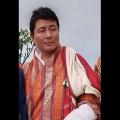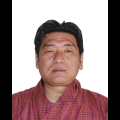Brief Background of Gewog.
Gasetsho Wongm (Lower Gaselo) gewog is located towards the south west from the Wangdue Dzongkhag. The Geog consists of 5 Tshogpas with the total of 9 villages (Phakha, Shingkhey khatoe, Shingkhey khamoe,Tapchakha, Mepisa, Mephina, Gikha,Hetshokha and Haebisa). The Geog has a population of about 863 consisting of 106 household covering an area of approximately 207.85square kilometer with the forest coverage of 71.43%.The terrain is mainly rugged with pockets of gently facing slopes. The Punatsang Chu and Tsirang highway runs along the gewogs eastern border, forming the border between Gasetsho Wom and Rubeisa Gewog.
The Geog Administration is staffed with elected personnel such as Gup, Mangmi, 5 Tshogpas , Geog Administrative Officer, Geog Clerk (Gedrung), Agriculture Extension officer, livestock Extension Officer, Extension Forest Officer and Gewog caretaker. The livestock and Forest Extension is shared from Gasetsho Gom with the shortage in extension officers in the Dzongkhag.
The Geog has a social infrastructure such as one RNR centre, one Community Primary School, Community centre, two ORC (Tapchekha and Haebisa) rendering basic services to the community. BHU services are shared with Gasetsho Gom Gewog and it has 26 water supply schemes, therefore 106 households are connected to save drinking water supply which makes100% RWSS coverage. The geog is fully connected by Basochhu Project feeder road from Gaselo feeder road to Basochhu intake and runs through Haebisa Chiwog and connects to Tsirang Highway. The gewog is also connected with farm road to rest of the chiwogs with 15.5km and has electrified in the entire households. Gewog has 100% coverage in telecommunication (B-moblie and Tashi Cell)
Rice is the main staple food in the geog. almost all the household grow paddy and remain self sufficiency in the food grains whole round the year. Maize, mastered plant, wheat is also grown in small scale. The vegetables grown in the geog are potatoes, chilies, turnip, radish, beans, cabbage, Cauliflower and garlic. Orange, banana, pomegranate, Guava plum, peaches are also grown as fruit for the domestic consumption only. The mastered plant cultivated to extracts oil for the consumption. The people in the gewog have interest in dairy farming and backyard poultry farming for their cash income.
|
Local Government |
||||||
|
Gewog Name: |
Gasetsho Wogm |
|||||
|
Geographical Location |
27o 23’44.42’’N 89o 53’25.46’’E 5555ft. |
|||||
|
Total Area (sq.kms) |
207.85Sqkm |
|||||
|
་Total No. of Chiwog |
5 |
|||||
|
Community center |
1 Located at Gewog center, Wasina |
|||||
|
Total Population |
Male |
Female |
Total |
|||
|
453 |
410 |
863 |
||||
|
Total No. of Villages |
9 |
|||||
|
No. of Households |
106 |
|||||
|
Business License Holder |
Nil |
|||||
|
Household with BBS and cable TV |
12 Household at Haebisa Connected with Cable TV, 9 Household has private Dish in rest of the Chiwogs ) |
|||||
|
Agriculture |
||
|
RNR extension centers |
1 |
|
|
Farmer’s cooperatives |
1 |
|
|
Irrigation schemes |
Number |
KMS |
|
15 |
38km |
|
|
No of Community forest |
4 |
|
|
Total Forest Coverage |
71.43% |
|
|
Education |
|||||||||||
|
No. of Schools |
HSS |
MSS |
PS |
ECR |
NFE |
TOTAL |
|||||
|
|
|
1 |
|
5 |
6 |
||||||
|
No. of Students |
Boys |
Girls |
Boys |
Girls |
Boys |
Girls |
Boys |
Girls |
Male |
Female |
Total |
|
- |
- |
- |
- |
84 |
113 |
- |
- |
7 |
45 |
249 |
|
|
No. of Teachers |
M |
F |
M |
F |
M |
F |
M |
F |
M |
F |
Total |
|
- |
- |
- |
- |
5 |
2 |
- |
- |
1 |
4 |
12 |
|
|
Teacher student ratio |
1:35 (teacher student ration excluding NFE) |
||||||||||
|
Health |
||||||
|
Hospital/BHUs/ORCs |
Hospital |
་ BHU |
ORC |
Total |
||
|
Nil |
Nil |
2 |
2 |
|||
|
RWSS Coverage |
No. Household With RWSS coverage |
Percentage (%) |
|
|||
|
106 |
100% |
|
||||
|
Electricity |
|||||
|
Household electrified |
No. |
% |
Household without Electrified |
No. |
% |
|
106 |
100 |
0 |
0 |
||
|
Tele-communication |
|
|
Village with Mobile network |
9 |
|
Village without mobile network |
Nil |
|
Roads Networks |
|
|
GC Roads (KMS) |
6 |
|
Farm Roads (KMS) |
15.5 |
|
Religion & Culture |
||||
|
Lhakhangs |
Govt. Owned |
Community |
Private |
Total |
|
0 |
4 |
1 |
5 |
|
|
|
Local Government |
|||||
|
Village Name Population |
Village |
household |
Male |
Female |
་ Total |
|
|
1. Phakha |
7 |
25 |
16 |
41 |
||
|
2. Shingkhey Khatoe |
10 |
44 |
48 |
92 |
||
|
3. Shngkhey Khamoe |
20 |
78 |
76 |
154 |
||
|
4. Tapchhekha |
6 |
33 |
29 |
62 |
||
|
5. Gikha |
9 |
43 |
42 |
85 |
||
|
6. Mebisa /Mephina |
8 |
44 |
31 |
75 |
||
|
7. Haetsokha |
11 |
58 |
60 |
118 |
||
|
8. Haebisa |
35 |
128 |
108 |
236 |
||
|
Total |
106 |
453 |
410 |
863 |
||
Civil Infrastructure
|
Sl. No |
Name |
Year of const. |
Remarks/Issues |
||||
|
1 |
Gewog Office |
2005 |
The old gewog office is affected by earthquake and new construction is going on. |
||||
|
2 |
RNR/ |
2012 |
|
||||
|
3 |
BHU/Hospitals/ORC |
2002 |
|
||||
|
4 |
Forest Range Office |
NA |
|
||||
|
5 |
Park Office |
NA |
|
||||
|
6 |
Veterinary Hospital |
NA |
|
||||
|
7 |
Community Center |
2013 |
|
||||
|
8 |
Haebisa Primary School |
2005 |
|
||||
|
9 |
Gewog Conference hall |
2012 |
|
||||
|
10 |
Kitchen cum Toilet |
2011 |
|
||||
|
|
|
|
|
||||
|
|
|
|
|
||||
|
No. of Farm Roads |
|||||||
|
Sl |
Name |
Length |
Const. Year |
Remarks |
|||
|
1 |
Shingkhey Farm Road
|
5km |
2012 |
|
|||
|
2 |
Gikha Farm road
|
1.5km |
2012 |
Constructed through CDG fund |
|||
|
3 |
Haetsokha Farm road
|
5km |
2010 |
|
|||
|
4 |
Mephina Farm road
|
2.5km |
2014 |
Const.through GDG fund |
|||
|
5 |
Dranag Goenpa Farm road |
1.5km |
2012 |
Const. through CDG fund later widened and maintained through RBOG fund 2014 .
|
|||
|
Livelihood |
|||||||
|
Sl |
Name of the crop/livestock |
Annual Production |
Remarks/ Issues |
||||
|
1 |
Paddy production (MT) |
280.00 |
Record as of 2014 Production Data |
||||
|
2 |
Wheat production (MT) |
24.52 |
,, |
||||
|
3 |
Potato production (MT) |
157.40 |
,, |
||||
|
4 |
Vegetable production (MT) |
95.56 |
,, |
||||
|
5 |
Milk production(MT) |
84.96 |
,, |
||||
|
6 |
Cheese Production(MT) |
7.65 |
,, |
||||
|
7 |
Butter production(MT) |
4.25 |
,, |
||||
|
8 |
Egg production (Doz.) |
2900.0 |
,, |
||||
|
9 |
Pork production (MT) |
1.17 |
,, |
||||
Cultural monuments
|
Sl |
Name of Lhakhang |
Description |
|
1 |
Thegchen Ugyen Dra Lhakhang |
Thegchen Ugyen Dra, also known as Jhana Goenpa located in the quite ambiance just above Haebisa primary school under Haebisa Chiwog was founded by Je Chejey Jamtsho in 18th century, who is believed to be the reincarnation of Langka Lam, the lam of Langka Goenpa which is located approxmitely 1km from chunzom. Je Chejey Jamtsho was born in Jamatshawa in Geney gewog under Thimphu Dzongkhag. Being the re-embodiment of Langka Lam, he was given the right mind of the lhakhang. Je Chejey was prophesized by the Goddess named Zhenchey Om, in his dream to set up his lhakhang in its present place. The main relic in the lhakhang at present is Jo Jamba founded by Je Chejey Jamtsho and the statue of goddess Zhenchey Om is preserved in save custodian and is access to glimpse to public in special occasion only. The lhakhang is taken care by the public, but the lhakhang is staffed with one lam and kangjob from zhung dratshang to offer daily rituals and take care of it. The sacredness of Nye at the Dranag goenpa is the image of Guru Rinpochhe which has appeared naturally from the big stone cave just adjacent to the lhakhang, now we can even see the image of Lord Buddha appeared from the same cave. The present lam at the lhakhang believed that there will be thousand Buddha Images appearing from the same stone. It is auspicious and worth visiting the lhakhang and nye. |
|
2 |
Haetsokha Community Lhakhang |
The lhakhang was founded in 20th century by Tshampa Dhendup and Gup Phub Dorji, both from Hetsokha. As a young boy Tshampa was a monk in Punakha Dzong. When he attained the age of 20, he left for Tibet to study profound Dharma but in his fourty, he returned back to his village. Seeing that there was no lhakhang in the village, he voiced on the necessity and recommended them to build one to which everyone assisted him. Hentsokha Lhakhang was previously known as Takchung lhakhang and was 10 minutes walk away from village, since the lhakhang was little bit far away and had no one to safeguard, they later moved the lhakhang to center of the village and named as Hentsokha Lhakhang. The chief relic in the Lhakhang is Chugche Zhey and it is said to have been brought from Paro Kurje Lhakhang. At present the lhakhang is renovated and looked after by the community turn wise for one to two years. The caretaker of the lhakhang has the right to use land owened in lhakhangs name. |
|
3 |
Gikha Community Lhakhang |
Gikha Lhakhang located in the Gikhka village under Tapchhekha Chiwog was built during Wangzop’s time. The Lhakhang is constructed by Wangzop Dalu Tashi Tobgay in 17th century. Previously the lhakhang has only one store and later the lhakhang was upgraded to two storeys by the public and requested the sewla Lam to consecrate the lhakhang. Sewla Lam could not visit the lhakhang but he consecrated the lhakhang from Sewla itself and blessed the lhakhang. It is considered as one of the secred lhakhang with good Nangtens in south of Wangdue Dzongkhag. The main relic in the lhakhang is Lham. Presently the lhakhang is taken care by villager’s in turn wise basis for one to two years. |
|
4 |
Shin Nyen Lhakhang |
Shin Nyen Lhakhang located in the heart of Shingkhey village is built by the commuinity of Shingkhey Village. The two storey lhakhang has the chief relic as Tempa statue, the lhakhang had major renovation in 2012 funded from 10th FYP budget. At Present the lhakhang is looked after by the community of upper Shingkhey and lower Shingkhey chiwog, since it benefits to both the chiwog. The caretaker appointed from the village in turn wise looks after the lhakhang and she/he has the right and privileges to cultivate in the land owned in the name of lhakhang. |
|
5 |
Simchutokha Lhakhang(Pvt.) |
Simchutokha Lhakhang located above the Shingkhey village about three hours walk was founded by Lam Tenzin Jamtsho four hundred years back. The Lhakhang is private owned and looked after by owners’ themselves. It is the fourth generation serving the lhakhang. It was founded by Lam Tenzin Jamtsho as his winter seat who had his summer seat above Lungtenphu known as Thadra Goenpa under Thimphu Dzongkhag. The lhakhang has the sacred relic as Phub, and it is kept in secret custodian without public view. The lhakhang is in need of renovation; in 2015 approached road to lhakhang is cleared through private contribution and donations. |
Bridge
|
Sl no |
Name and Type of bridge |
Year of construction |
remarks |
|
1 |
Lawa Lumpa RCC bridge
|
1997 |
|
|
2 |
Lawakha RCC bridge
|
2011 |
Const. by Japan govt.(Along Wangdue Tsirang highway) |
|
3 |
Basozam RCC bridge
|
2011 |
Const. by Japan Govt. (Along Wangdue Tsirang highway) |
|
4 |
Shatshozam Bailey Bridge. (Near intake )
|
1997
|
Built by Basochu Project |



